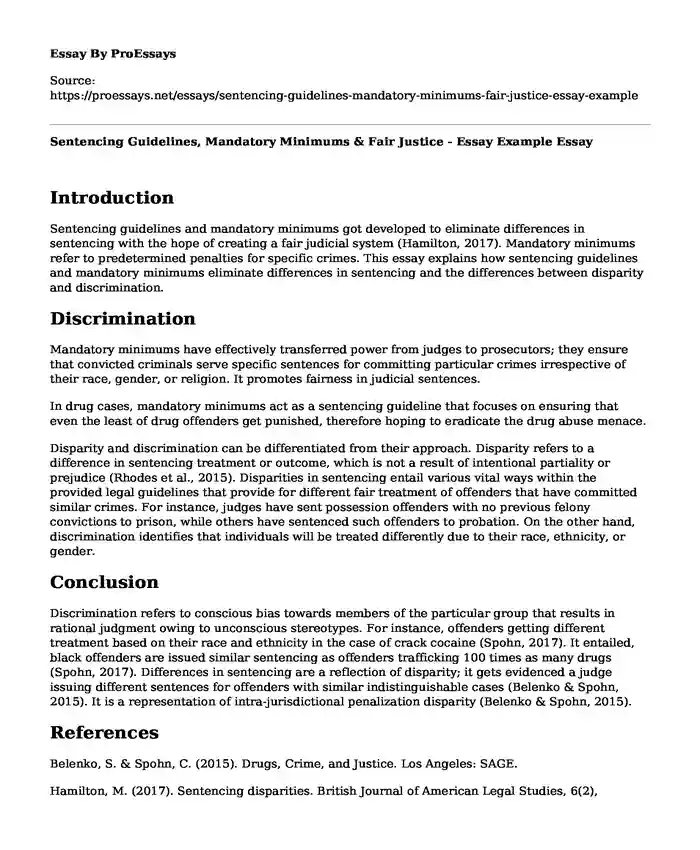Introduction
Sentencing guidelines and mandatory minimums got developed to eliminate differences in sentencing with the hope of creating a fair judicial system (Hamilton, 2017). Mandatory minimums refer to predetermined penalties for specific crimes. This essay explains how sentencing guidelines and mandatory minimums eliminate differences in sentencing and the differences between disparity and discrimination.
Discrimination
Mandatory minimums have effectively transferred power from judges to prosecutors; they ensure that convicted criminals serve specific sentences for committing particular crimes irrespective of their race, gender, or religion. It promotes fairness in judicial sentences.
In drug cases, mandatory minimums act as a sentencing guideline that focuses on ensuring that even the least of drug offenders get punished, therefore hoping to eradicate the drug abuse menace.
Disparity and discrimination can be differentiated from their approach. Disparity refers to a difference in sentencing treatment or outcome, which is not a result of intentional partiality or prejudice (Rhodes et al., 2015). Disparities in sentencing entail various vital ways within the provided legal guidelines that provide for different fair treatment of offenders that have committed similar crimes. For instance, judges have sent possession offenders with no previous felony convictions to prison, while others have sentenced such offenders to probation. On the other hand, discrimination identifies that individuals will be treated differently due to their race, ethnicity, or gender.
Conclusion
Discrimination refers to conscious bias towards members of the particular group that results in rational judgment owing to unconscious stereotypes. For instance, offenders getting different treatment based on their race and ethnicity in the case of crack cocaine (Spohn, 2017). It entailed, black offenders are issued similar sentencing as offenders trafficking 100 times as many drugs (Spohn, 2017). Differences in sentencing are a reflection of disparity; it gets evidenced a judge issuing different sentences for offenders with similar indistinguishable cases (Belenko & Spohn, 2015). It is a representation of intra-jurisdictional penalization disparity (Belenko & Spohn, 2015).
References
Belenko, S. & Spohn, C. (2015). Drugs, Crime, and Justice. Los Angeles: SAGE.
Hamilton, M. (2017). Sentencing disparities. British Journal of American Legal Studies, 6(2), 177-224. Retrieved from https://content.sciendo.com/view/journals/bjals/6/2/article-p177.xml
Rhodes, W. M., Kling, R., Luallen, J., & Dyous, C. (2015). Federal sentencing disparity: 2005-2012. Washington, DC: Bureau of Justice Statistics.
Spohn, C. (2017). Race and sentencing disparity. Reforming criminal justice: A report of the Academy for Justice on bridging the gap between scholarship and reform, 4, 169-186. Retrieved from: https://law.asu.edu/sites/default/files/pdf/academy_for_justice/9_Criminal_Justice_Reform_Vol_4_Race-and-Sentencing-Disparity.pdf
Cite this page
Sentencing Guidelines, Mandatory Minimums & Fair Justice - Essay Example. (2023, Oct 12). Retrieved from https://proessays.net/essays/sentencing-guidelines-mandatory-minimums-fair-justice-essay-example
If you are the original author of this essay and no longer wish to have it published on the ProEssays website, please click below to request its removal:
- Paper Example on Problem-Solving Courts
- Inequality in the Ivy League Essay Example
- Essay Sample on Psychology and Poverty
- Research Paper on Concepts of Competency, Integrity, Boundaries, and Social Justice
- Culture a Key Factor in Violence Against Women: Patriarchy Promotes Abuse - Essay Sample
- Essay Example on Workplace Violence: Understanding & Mitigating Factors
- The Reality of Racial Inequality in the US: A Look Into Personal Lives - Research Paper







